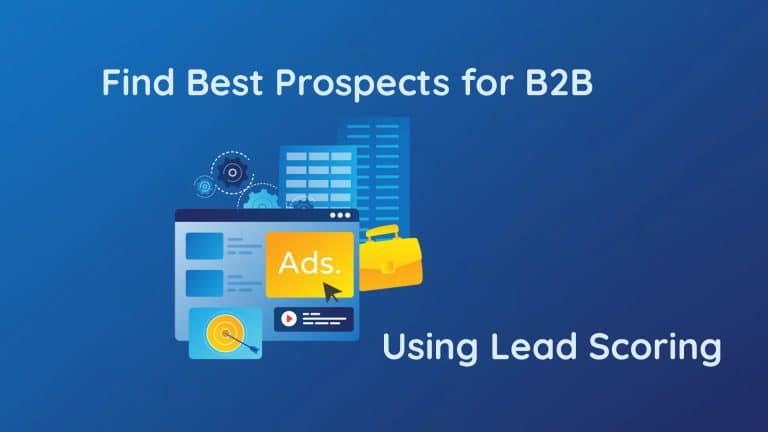Account-based marketing is a method of targeting and engaging high-value accounts in B2B marketing. Rather than casting a wide net and trying to reach as many potential customers as possible, ABM is about identifying and prioritizing a specific group of accounts that align with your business goals and customizing your marketing efforts to those accounts.
This can be accomplished by tailoring campaigns and content to the unique pain points and requirements of each target account, rather than utilizing a broad, one-size-fits-all strategy.
ABM also involves a collaborative approach between sales and marketing teams working together to identify, engage and close deals with target accounts. This collaboration increases the chances of success by ensuring that the right message is sent to the right people at the right time.
ABM is account-based “marketing,” but revealing accounts from marketing results in MQLs (Marketing Qualified Leads) becomes SQLs (Sales Qualified Leads).
Overall, ABM is a targeted, data-driven approach that allows companies to focus their resources on accounts likely to yield the greatest return.

The basics of account-based marketing and how it differs from traditional marketing strategies
Traditional marketing strategies such as outbound marketing and inbound marketing focus on reaching a broad audience through various channels such as email, social media, and paid advertising. In contrast, ABM is a highly targeted and personalized approach that focuses on specific, high-value accounts. Rather than trying to reach many potential customers, ABM focuses on a smaller number of key accounts that align with the company’s goals.
Traditional marketing focuses on creating generic content and campaigns designed to appeal to a broad audience. ABM, on the other hand, focuses on creating personalized content and campaigns that are specific to the problems and needs of individual target accounts.
A crucial contrast between traditional marketing and ABM is the way teams operate. Traditional marketing practices tend to feature siloed efforts, where sales and marketing teams operate independently of one another. On the other hand, ABM necessitates close coordination and partnership between sales and marketing teams to effectively identify and engage target accounts.
Benefits of implementing an ABM strategy
ABM strategies can bring many benefits to companies, some of which include:
- Higher ROI: By focusing on high-value accounts that align with business goals, ABM can contribute to a higher return on investment compared to traditional marketing strategies.
- Better alignment between sales and marketing: ABM requires close collaboration between sales and marketing teams, which can lead to better alignment and more effective lead generation and customer retention.
- Greater efficiency: ABM enables companies to focus resources on accounts likely to generate a high return on investment, rather than wasting resources on numerous low-value leads.
- Better understanding of target accounts: Companies can gain a deeper understanding of their target accounts’ needs, concerns, and buying behaviors, which can impact future marketing and sales efforts.
- Better customer retention and engagement: Companies can improve customer retention and loyalty with personalized campaigns that address specific issues. This also leads to more effective customer engagement.
How to identify and target the right accounts for your ABM campaign
1. Researching and selecting ideal accounts:
The first step to ABM is to choose the accounts with whom you can achieve your business goals and generate a return on investment. To do this, research and evaluate potential accounts based on things like size, industry, and location. Once you have a list of target accounts, prioritize them based on their potential value to your business.
2. Creating buyer personas and understanding their pain points:
Once target accounts are identified and prioritized, it’s important to create detailed buyer personas that represent the key decision makers and influencers within each account. To do this, you’ll need to research and understand the demographics, job titles, problems, and buying behaviors of these personas. By understanding the specific needs and problems of each persona, you can develop a customized approach that addresses those needs and resonates better with your target audiences.
3. Developing a customized approach for each target account:
With targets’ needs and pain points in mind, companies can develop a customized approach that addresses those needs and is likely to resonate. This can include tailored content, campaigns, and messages that speak directly to the target account’s needs. Besides, you should choose an approach that works for each account, as they may have different needs and buying behaviors.
Why focus on accounts instead of leads?
Traditional marketing techniques, such as outbound and inbound marketing, tend to concentrate on reaching a broad range of potential customers. However, not every lead is the same and many may not be ready to make a purchase. Therefore, this can lead to wasted resources and a low conversion rate.
On the other hand, ABM focuses on targeting specific, high-value accounts who match business goals. By focusing on a smaller number of key accounts, companies can use their resources more efficiently and increase the chances of closing deals and revenue.
How to build an ABM strategy
After identifying and targeting the right accounts, follow these steps:
1. Developing a plan for communicating across multiple channels:
To engage target accounts, develop a plan that includes email, social media, and paid advertising. Plan for each account individually and consider their specific needs and pain points.
2. Creating personalized content and campaigns:
Knowing the needs and problems of each target accounts helps companies create content that addresses those needs and is likely to resonate well with the target audience.
Account-based marketing tactics:
- In-person events
- Email campaigns
- Webinars
- Direct Mail
- Paid advertising
- Web personalization
3. Measuring and analyzing the success of ABM results:
To assess your ABM strategy, measure key outcomes, and track and evaluate the impact on sales and customer retention. By constantly analyzing the data, companies can improve their ABM strategy to achieve better results.
Examples of successful ABM implementations
Personalized storytelling by GumGum
GumGum, a company specializing in applied computer vision, used a unique ABM approach to win a deal with T-Mobile. They discovered that the CEO of T-Mobile was a huge fan of Batman, so they designed a custom comic book called “T-man and Gums” and distributed 100 copies to key people in T-Mobile’s agency. In this way, GumGum not only got to know its target audience, but also built a personal relationship through personalized storytelling. This is just one example of how using specific information about a brand can lead to targeted and effective interactions.
Picture showcasing by Robin
Robin, a provider of conference room scheduling software, had success with an account-based marketing campaign that leveraged the power of images. Instead of focusing solely on the software’s features, the company decided to showcase its customers’ beautiful office spaces on its website. This simple approach proved to be very effective in attracting new customers. The number of visitors to the website increased by 50% and the number of leads by 20%. This case shows that innovative, low-cost marketing ideas can be just as effective as those that require large investments.
Account Scoring on websites
Account scoring is a technique used in ABM to assess the potential value of a website visitor based on their business and behavior on the website. This can help companies identify and prioritize high-value accounts that meet their business goals.
To implement account scoring, companies can use account-based marketing software that can integrate with their website analytics. This software can track and evaluate a variety of visitor characteristics such as company size, industry, and website behavior. Based on this data, the software assigns a score to each visitor to prioritize and target specific accounts.
ABM is a B2B strategy that targets specific, high-value accounts. It’s not typically used in B2C because it aims to reach a broad audience (to increase brand awareness or generate leads) rather than build relationships with specific accounts. Additionally, B2B customers tend to be larger and more complex than B2C customers, making it more difficult to reach them with general marketing methods. However, some B2C companies use ABM strategies to target specific high-value customers, such as luxury brands or premium subscription services.
Maximizing your ABM strategy with the tools
These tools can help automate and optimize various aspects of the ABM process, such as identifying and targeting specific accounts, creating personalized content and campaigns, and measuring and analyzing the success of the ABM strategy.
Demandbase
Demandbase is an all-in-one account intelligence tool that provides a comprehensive solution for sales and marketing teams. The platform uses a variety of attributes such as firmographic, technographic, keywords and news, to identify accounts in the market that are a good fit for your criteria. With its Account-based Experience (ABX) cloud, Demandbase can automate many manual and repetitive marketing tasks and even suggest personalized digital experiences for key customers, such as industry insights based on initial sales conversations.
6Sense
Unlike Demandbase, 6Sense’s main goal is to illuminate all the hidden elements of the buyer journey across all channels. The platform starts by analyzing all existing customer relationships from the CRM and then suggests related accounts from its own database and adds them to the buyer journey. After that, 6Sense makes it easy to tailor digital experiences, such as email marketing, to high-value prospects. Besides, 6sense provides AI-powered insights for sales, such as the names of companies that have visited the site, making it easier for the sales team to follow up.
Connect with our experts for guidance on achieving success with account-based marketing (ABM).



